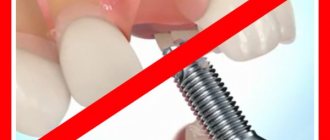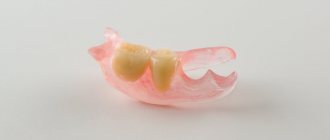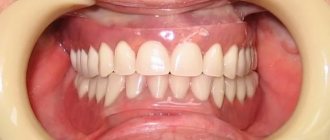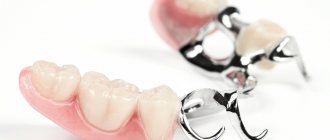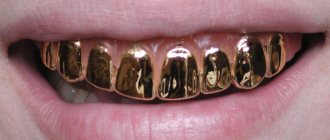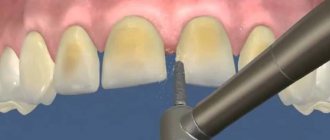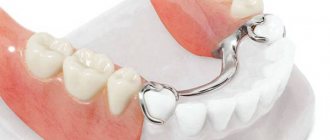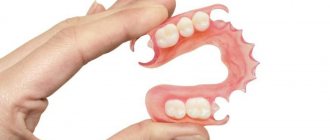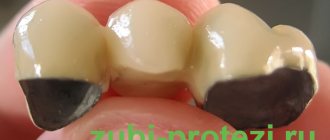- Indications for installation
- Manufacturing process
- Advantages and disadvantages
- Care
Porcelain crowns are particularly aesthetically pleasing and do not contain metal.
They are indistinguishable from natural teeth and are used in orthopedic dentistry for aesthetic restoration of the dentition. If a patient is allergic to metal, porcelain crowns will help solve the problem. The material is absolutely inert, does not interact with the body, does not irritate soft tissues and does not stain them. Crowns consist of a thin layer of ceramic. If bridge prosthetics is necessary, the ceramics are strengthened with a zirconium dioxide bridge to acquire the desired properties.
Indications for the installation of porcelain crowns
The main indication for the installation of porcelain crowns is the aesthetic restoration of the front teeth:
· wedge-shaped defects and chips that cannot be eliminated using filling material;
Complete destruction of the dental crown;
· enamel hypoplasia;
Abnormalities in tooth color or shape;
· a pronounced change in the shade of tooth enamel that cannot be corrected using professional hygiene methods.
In addition, such designs are suitable for patients who are allergic to metal.
Advantages and disadvantages
The main advantage of porcelain products is their maximum identity with natural units.
Moreover, the aesthetics remain unchanged throughout the entire period of wearing. An important bonus for patients are other characteristics of the material:
- hypoallergenic;
- do not stain even when worn for a long time;
- biological inertness (compatibility);
- sufficient hardness.
Porcelain is not an ideal material. It has some disadvantages:
- fragility due to small wall thickness;
- high abrasiveness, which negatively affects neighboring teeth;
- the amount of grinding of the tooth walls is higher than, for example, with gold crowns;
- there is no perfect fit to the gum;
- articulation deteriorates due to weakening of the fastening;
- high price compared to products made from other materials.
Important! The disadvantages can be considered conditional, since with strict adherence to the manufacturing, fastening and subsequent operation methods, they do not manifest themselves in any way.
Stages of manufacturing and installation of porcelain crowns
First of all, at the appointment, the dentist examines the patient’s oral cavity, identifies possible contraindications, and, if necessary, carries out a complete sanitation. Only after this can you proceed to the next stage - preparing the tooth for a porcelain crown and selecting the optimal shade for the future design using a special template.
Next, the doctor takes a combined impression of the tooth and the entire dentition. And if the quality of the casts is satisfactory, it is sent to a dental laboratory, where a plaster model is made based on them.
Direct production of a porcelain crown can be carried out in two ways. The first involves layer-by-layer application of porcelain substance, and the second uses injection molding technology. It is the second option that is more modern and gives the structure high strength,
Therefore, it is used in most dental laboratories.
After the impression falls into the hands of a specialist, he uses thin platinum foil to create a mold for the future dental crown and fills it with a porcelain composition, and then exposes it to high temperatures several times.
The final stage of making a porcelain crown is the correction of the structure, its staining and glazing.
After the crown is ready, it is first tried on. If the result suits both the doctor and the patient, it is finally fixed on the previously prepared tooth.
Contraindications for use
Experts do not recommend installing porcelain if, during an examination of the oral cavity, the doctor reveals certain conditions. Some of them:
- insufficient hardness of the dental bone tissue;
- inflammatory processes in the acute stage;
- severe occlusion disorders;
- chronic periodontal disease in the acute stage;
- absence of a large number of teeth.
All contraindications are considered absolute and have nothing to do with the fact that the material has high hardness and almost does not wear off. This often leads to overload of the periodontium of supporting teeth, thereby worsening the course of pathologies. In addition, there are a number of relative contraindications:
- bruxism (dysfunction of the masticatory muscles);
- “living” pulp of the incisors on the lower jaw;
- excessive abrasion of enamel;
- pathologies of occlusion, which are associated with strong crossing of the incisors.
When these limitations are eliminated by the method of complex treatment, the necessary conditions are created for the manufacture of porcelain prostheses.
Before and after installation
Benefits of porcelain crowns
· High aesthetics. Porcelain has almost ideal optical characteristics. It very accurately conveys the natural shade and translucency that are characteristic of natural tooth enamel.
· Hypoallergenic design and inert material. Porcelain does not have thermal conductivity, so tooth sensitivity to temperature changes is reduced. Since the crown does not contain a single gram of metal, it can be installed in patients who are allergic to it.
· Long service life. With proper care, the structure will last a very long time, approximately 10-15 years, without losing its performance characteristics.
· Resistant to staining and darkening. Porcelain crowns do not lose their shade and shine, maintaining their original appearance for a long time.
· Minimum adaptation time. The patient quickly gets used to the lightweight and comfortable design.
· Easy to care for. Crowns do not require special care. It is enough to use a high-quality toothbrush and toothpaste, and treat them with care.
Kinds
Based on how the crowns will be attached to the base, they are divided into classes:
- Diatoric.
- Crampons.
The first group of structures are hollow inside products , fixed to the base with dental cement. Often because of this they are also called perforated. Typically used to restore lateral teeth.
The second group includes crowns that have a crown - an element that fixes an artificial unit , made of metal wire.
Most often, the material for wire is palladium or silver, since the thermal expansion coefficient of these metals is close to the properties of porcelain when fired. Crampon crowns are usually placed in the frontal area of the mouth.
Disadvantages of porcelain crowns
· High cost of construction. It is due to the complexity of technical work, which requires very high professionalism from a specialist.
· Relative fragility of the material. Patients have to avoid eating solid foods.
· Restrictions on indications. Porcelain crowns are not placed on all teeth.
· Manufacturing of single crowns only. Porcelain is not suitable for creating and installing bridges.
Care instructions
Everyone knows that proper daily dental care is the basis of health. However, after installing porcelain products, you need to take more careful care of your oral cavity. To increase the service life of crowns, you need to follow some recommendations:
- Do not place excessive pressure on the prosthesis.
- If possible, avoid eating solid and tough foods.
- Providing quality oral care - brushing your teeth 2 times a day, rinsing your mouth after snacks with still water or mouthwash, and cleaning in between with dental floss.
- All hygiene products must be selected by a doctor.
- Carry out dental cleanings annually.
- Visit a specialist twice a year for a preventive examination.
Today, porcelain crowns are the most popular prosthetic products, despite their high price. Most people prefer not to save on their teeth, installing structures made from quality materials. With proper care and following the advice of specialists, dentures will serve their owners for a very long time.
Varieties of porcelain designs
Dental porcelain is an excellent material that provides ample opportunities for aesthetic restoration. Several types of structures are made from it:
· Veneers. These are thin plates designed to hide minor defects in tooth enamel. They cover only the front surface of the tooth. Porcelain, composite or zirconium dioxide can be used in their manufacturing process.
· Tabs. These are microprostheses made in a dental laboratory. They help solve more serious dental problems with teeth and are used, for example, in cases of severe decay of the crown or the presence of a large carious cavity.
· Crowns. The most versatile design that allows you to achieve a “Hollywood” smile. They are installed on the front teeth during aesthetic restoration.
How to care
If a patient chooses porcelain as a material for teeth, then he must remember that such crowns require care in the same way as natural ones. Despite the fact that the tooth is relatively protected from destruction, the gum area is vulnerable. Thorough brushing of teeth with a quality fluoride toothpaste is still essential. Lack of proper dental care, for example, irregular brushing, simultaneous intake of cold and hot food can deteriorate the quality of the crown during its operation.
Metal ceramics or porcelain: what to choose?
This question arises among patients quite often. After all, each design has its own advantages and disadvantages. Thus, metal ceramics are distinguished by their high strength and affordable price, and porcelain has excellent aesthetic characteristics. Typically, the choice between them depends on which tooth needs to be restored. Crowns made of metal-ceramics are most often installed on chewing teeth, and porcelain crowns are installed on incisors and canines. However, if a porcelain crown has a zirconia framework, it can be used to restore any tooth.
Comparison: plastic or porcelain teeth
It is important not to allow the porcelain crown to overheat during processing, as this can cause a crack to appear, followed by possible separation of part of it.
When comparing plastic and porcelain crowns, it is worth noting the advantageous aspects of polymer products:
- crowns made of plastic do not have the fragility that is inherent in porcelain;
- abrasive processing or grinding of plastic crowns is much easier;
- Reliability in operation of plastic teeth is determined by the ease of their installation.
At the same time, porcelain teeth are not subject to changes in their inherent size and shape. They do not soften or deform when exposed to temperature conditions. Porcelain products are less susceptible to abrasion of work surfaces due to their increased hardness. The same comparative criteria can be applied when choosing material for removable dentures.
Installation
Placement of the prosthesis is a simple process. First, it is fixed to the stump using temporary cement. If within 2-3 weeks the patient does not make any complaints, if he does not experience any unpleasant sensations or discomfort, the crown is secured with permanent cement.
Here, the specialist is required to choose the right color of the cement mass so that the junction of the crown with the base does not stand out and completely matches the shade of the neighboring units.
Before fastening, the crown itself and the teeth adjacent to it are treated with an antiseptic, and the work area is isolated from saliva and moisture. Afterwards, the cement is put into the product, which is immediately put on the stump.
On average, it takes 30 to 40 minutes to install one crown. The patient is sent home after the doctor is convinced that the cement has hardened well.
Manufacturing
Before you begin making crowns, you need to prepare the tooth and make a high-quality impression of the jaw. The thickness of the porcelain structure is small, no more than 1.5 mm.
This is how long the enamel of the tooth being restored is removed and is necessary for the crown to fit tightly to it. In order for the prosthesis to fit perfectly, it is important to achieve optimal taper and create the necessary ledge.
After the tooth is prepared, an accurate silicone impression is made. Accuracy at this stage is very important. The impression must take into account not only the shape of the tooth itself, but also the gingival ledge and the distance between adjacent teeth.
9 reasons for pain under a crown
A silicone impression compound is also applied to the upper teeth in order to most accurately model the design taking into account the impression of the opposite jaw.
The crown manufacturing process consists of three main stages:
- Making a matrix according to the impressions made. This matrix is then filled with porcelain mass.
- Preparing a mass of a pre-selected shade and filling the matrix with it.
- Adding strength to the resulting crown by firing.
During individual manufacturing, the patient is asked to try on the restoration structure several times. During fitting, the dentist checks how well the crown fits the tooth, its size and shape. At this stage, the selection of its color also takes place.
For the manufacture of all types of porcelain structures, the pressing method is used, which, in turn, is divided into two methods:
- Surface painting.
- Layering.
The use of one method or another depends on the location of the teeth being restored. Experts advise using the surface staining method for making lateral teeth, and the layering method for the front ones.
Life time
Based on practical observations, the service life of porcelain crowns can range from 10 to 15 years.
The duration of their operation is influenced by the following factors:
- The fragility of the material , as a result of which, the appearance of even a small crack in the product, after some time, leads to strong growth, i.e. the entire structure falls into disrepair.
- Fast washability. This is especially common in patients who constantly clench their teeth.
Even minor destruction of the prosthesis allows pathogenic flora to freely penetrate under it and destroy the unit underneath. In such a situation, secondary caries quickly develops, for the treatment of which the structure will have to be removed.
Important! If you feel that the structure is moving when chewing food, you should not try to resolve the situation on your own. Only an orthopedic dentist can correct the problem correctly.
